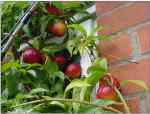
PEACHES AND NECTARINES
There are two varieties of peach -(Amygdalus Persica), and the trees are pretty similar; the peach with a downy coat, and the nectarine. No-one knows what country the peach came from. The Romans called it Persica, so it probably came from Persia, but we don't know whether it originated from there or whether it came from a country nearer the equator. When growing wild, the peach is quite a small tree, with wide spreading branches. The flowers appear before the leaves, and have hardly any scent. The fruit is roundish, with a furrow along one side, and has a very downy cuticle when ripe. Peaches are in two classes - those which separate easily from the stone, and those which don't. Those which do are usually the best flavoured, but there are exceptions. The varieties of peach are very numerous; about two hundred types in the catalogue of the RHS. The qualities of the peach depend on the soil and the climate; the soil must not be too rich or too poor. If too rich the tree gets too big; if too poor, the fruit lacks flavour.
We know just as little about the nectarine. Delicious as the peach is, the nectarine, when of a good sort and properly cultivated, is superior.
In the warmer parts of Asia the peach is widely grown, and it frequently grows wild.
It also grows iin America, in abundance. Captain Head, in "Rough Notes", mentions the beauty and productive ness of the peach treeswhich are scattered over the cornfields near Mendoza, east of the Andes, and he also notes dried peaches as food in the mountains.
In many parts of the United States, peach trees grow in extensive plantations. They continue without culture, and the fruit is of little value except for making peach brandy and fattening hogs. The following account of peach orchards in the United States, and of a variety of peach which came from that country, was sent to the Horticultural Society in 1815 by John Braddick of Thames Ditton:
"Some years ago when travelling through Maryland, Virginia, and the neighbouring provinces, I saw the way their peach-trees were cultivated. They were invariably grown from stones, the plant never being budded, but always remaining in a state of nature. In the middle and southern provinces a planter often has enough trees to make (after fermenting and distilling) from fifty to a hundred gallons of peach brandy; the manufacturing of it, and the feeding of pigs being the main use to which the fruit is put. A peach orchard usually contains a thousand or more standard trees. The fruit growing on the trees is an endless variety, scarcely two trees producing exactly alike. There are a few trees, of course, where the fruit is exceptional and the type worthy of propogating."
The peach is said to have been first cultivated in England about the middle of the 1500s. Gerard describes several varieties as growing in his garden, and Tusser mentions it in his list of fruits in 1557.
.....taken from "A Description and History of Vegatable Substances used in The Arts and in Domestic Economy; Timber Trees ; Fruits", by Charles Knight, Pall Mall East; pub. Longman, Rees, Orme, Brown & Green, Paternoster Row. 1829.
Paraphrased by Nigel Deacon
